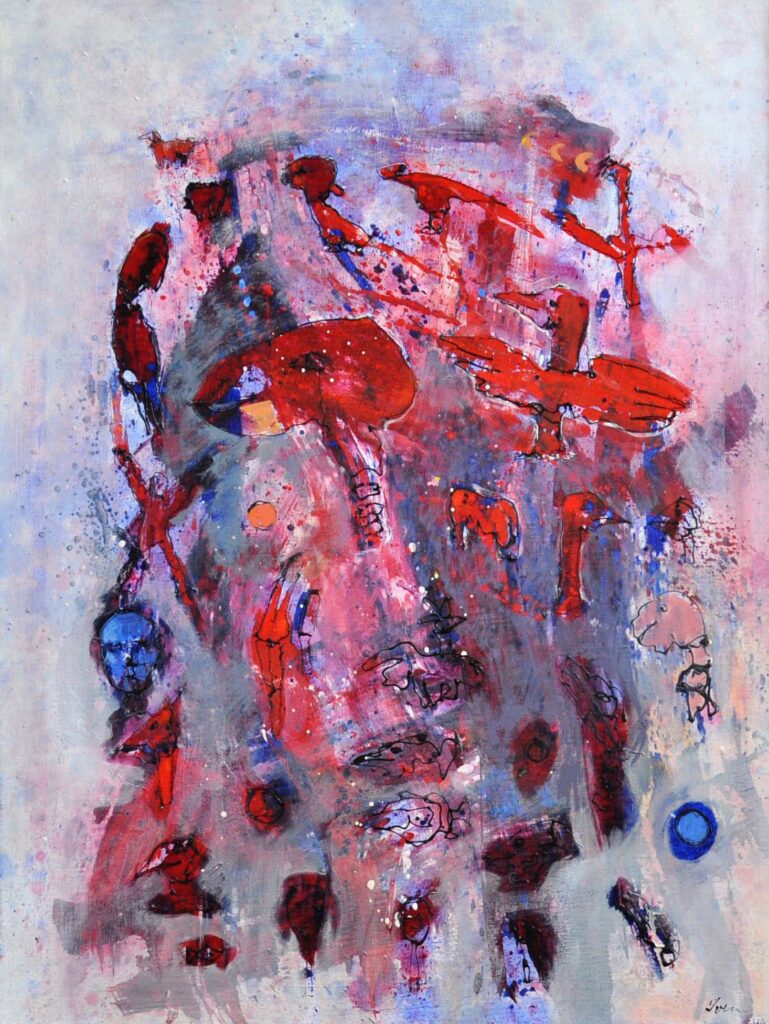By creating the nonverbal myths on my canvasses I hope to reach the onlooker in a way that brings our minds together so we can walk the paths of understanding – dreaming the very old dreams of humanity.
Therefore I work very intensely with drawings of the human and the animal form, a work that has been going on for many years. This work is in every way necessary for the creation of my fabulations in oil and acrylic on canvas often in big measures.
Of course one asks: When will it stop, when is the goal conquered, when will I have painted the picture that is so high and wild I will never need to paint another. But that is not the way it works, it is rather like a well from which I divert the power and the questions that leads to the next painting. It is a never ending process, and every time a peak has been reached, there is another one to be climbed.
Therefore my work as an artist is a very serious business but at the same time a great source of joy and understanding.

A Danish writer, Elsa Gress, once said about real artists that they were like driven by demons, and being part of that scene quite involuntary, the thought often knocks on my consciousness: Why go on, why walk searching in candlelight for some road that might not be there? Why working and looking for something which might not be found – or found and quickly forgotten by oneself and also by the audience.
To me the story of the singing of the honeyant is the answer to the search and all the toils and troubles of the road.
And if you don´t remember the story – or maybe never has heard it, I will sketch it shortly in the following lines, because it so precisely tells why I for example is willing to go on painting and really not able to stop the rather tedious work.
Why.
Being engaged in a struggle for understanding and searching for an expression with the most precise and nescessary substance, I sometimes wonder: why do it? Why use so much time and so many efforts to create a work of art?
When in doubt about the meaning of it all, I remember the ancedote about the Honey Ant Song, and the sheer beauty of it makes me go on and on.
In 1971 an australian teacher Geoffrey Robert Bardon ( 1940-2003) persuaded some aboriginal men from the Pintupi tribe to make a painting on a wall of a school in Papunja, an aboriginal settlement 250 km. west of Alice Springs. The name of the painting was Honey Ant Dreaming, and it contained the secrets of the aboriginals showing the symbols from the time of creation or dreamtime, when the ancestral beings wandered the earth. The painting became the start of the Western Desert Painting Movement, and this part of the story is very well know to day as well as the marvelous art of the aboriginals.

Geoffrey Bardon with the ‘Honey Ant Dreaming’ Mural at the Papunya School
This anecdote got a new meaning for me on a juried exhibition in Roskilde in november 2011. I had received an award, and there was a session, where the judges gave their arguments for the awards. One of the judges, a very competent, young female artist, explained my picture exactly, as I had intended it in every detail. In her speech she showed a very precise understanding of the goals, the means and message. This demonstrated clearly to me, that there is a common languge some of us understand, there is a Honey Art Song and an expression, that can be transported from one human to another on many levels – and with much beauty.
That is why it is so important to go on striving to reach ones artistic goals.
